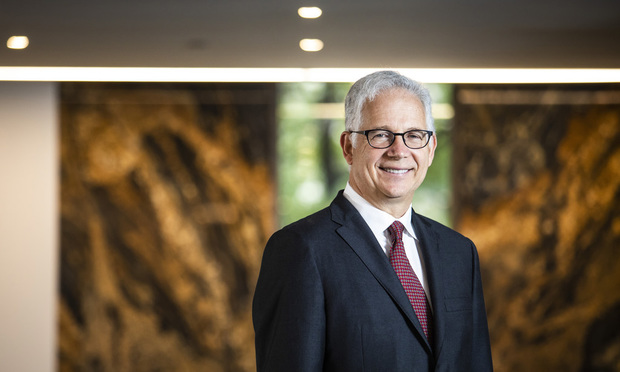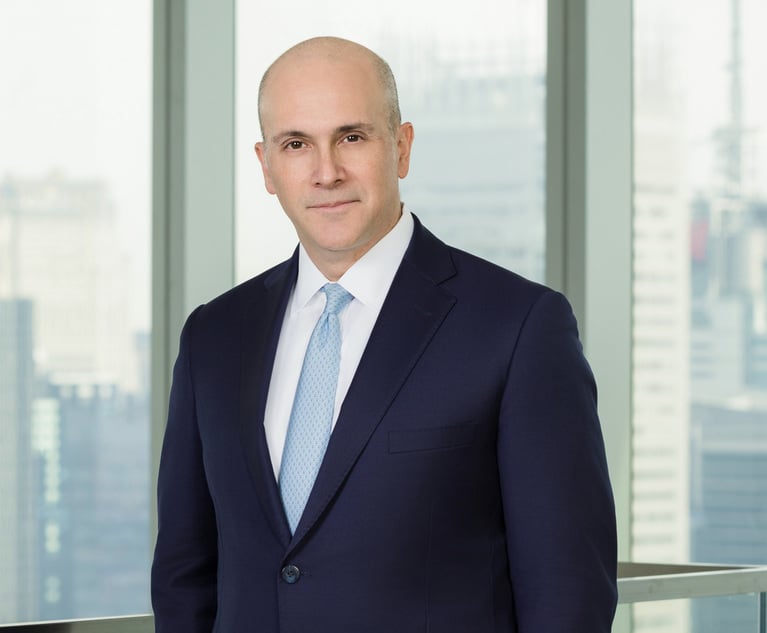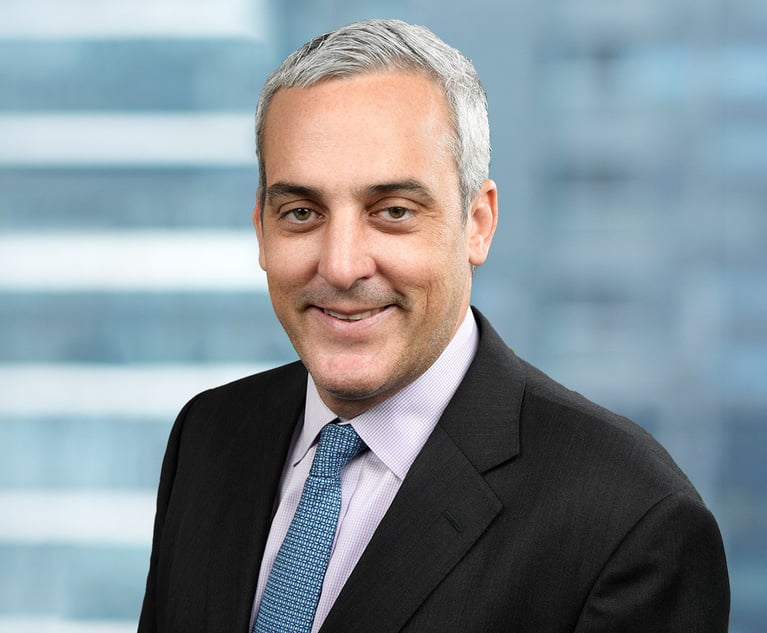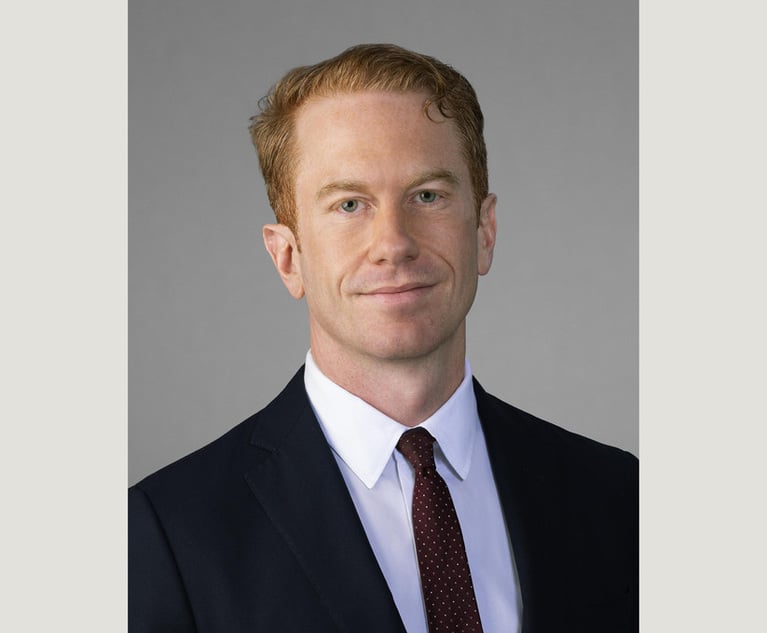Attorney of the Year Finalist David Sanford Is a Force for Equality
Sanford is helping women around the industry fight against the wage gap.
October 28, 2018 at 08:00 PM
4 minute read
 David Sanford, chairman and co-founder of Sanford Heisler Sharp. Photo: Diego Radzinschi.
David Sanford, chairman and co-founder of Sanford Heisler Sharp. Photo: Diego Radzinschi.
Before David Sanford began litigating gender bias claims against large law firms, he didn't have any master plan to effect change for women in the legal profession, he says. But after several high-profile cases, and settlements worth millions of dollars, his work has shined a light on Big Law's gender gap and helped to chip away at stubborn inequality.
Sanford, chairman of the class action firm Sanford Heisler Sharp, has guided several female partners who felt they were given short shrift at their firms to settlements with the likes of Chadbourne & Parke (now part of Norton Rose Fulbright), the now-collapsed Sedgwick and Proskauer Rose. He's also lead counsel on similar cases pending against Jones Day, Ogletree, Deakins, Nash, Smoak & Stewart and others.
Sanford says “there is absolutely no doubt” those cases impacted the legal industry, exposing potential discrimination and the ways in which opaque partner compensation systems can contribute to the pay gap.
“There's a sea change that has occurred in the legal profession, I believe, based on the activities of our firm in assisting female attorneys, mostly female partners, to get the pay that they deserve,” Sanford says.
His work as lead counsel on the law firm gender cases unmistakably raised awareness about the Big Law gender gap, says Kerrie Campbell of K-Campbell Law, the lead plaintiff in the Chadbourne suit, which ended with a $3 million settlement for her and two other former Chadbourne partners.
Campbell explains that threats of litigation, public scrutiny in the press and potential high-dollar payouts have upended the status quo at large law firms. She credits Sanford's approach as a lawyer who can “go toe-to-toe with any marquee defense firm” while also providing his clients with an “extraordinarily rare” level of responsiveness and support.
“David—like no one else—has put law firms, insurance carriers and defense counsel on notice that Big Law can and will be held accountable for unlawful discriminatory practices,” Campbell says. “With David's representation and support, more women in the legal industry than ever before have come forward and taken a stand against unlawful and discriminatory conduct.”
Sanford recognizes the important role of the women he has represented—women who have been willing to take their bias claims public, even in the face of professional or reputational harm. While that position can be an exceptionally difficult one, Sanford says his clients tend to resolve their cases for large sums of money, and have been able to continue their careers with success.
The cases have brought a much-needed focus, he says, on compensation systems at law firms, which often place outsize power in the hands of firm leaders who are more likely to be men than women. Law firms can do better with their pay and promotion decisions, he says.
“One of the things that our litigation matters show is that firms have a deep-rooted problem because they are unwilling, to date, to have the kind of transparency and sharing of information that is typically required of firms with shareholders,” Sanford says. “For the first time there is a lot of discussion among people in power in law firms … about what to do, either to avoid this kind of action, or in light of it.”
When the industry falls short, Sanford and his firm will be watching.
“There's a lot more work to be done,” Sanford says, “and we're going to be doing a lot of that work.”
Email: [email protected]
This content has been archived. It is available through our partners, LexisNexis® and Bloomberg Law.
To view this content, please continue to their sites.
Not a Lexis Subscriber?
Subscribe Now
Not a Bloomberg Law Subscriber?
Subscribe Now
NOT FOR REPRINT
© 2025 ALM Global, LLC, All Rights Reserved. Request academic re-use from www.copyright.com. All other uses, submit a request to [email protected]. For more information visit Asset & Logo Licensing.
You Might Like
View All

What Happens When Lateral Partners’ Guaranteed Compensation Ends?

Latham Adds Former Treasury Department Lawyer for Cross-Border Deal Guidance
2 minute read
Wachtell Partner Leaves to Chair Latham's Liability Management Practice
2 minute readTrending Stories
- 1FTX One Year Later: The Impact on Examiner Practice in Bankruptcy Courts
- 2Gen AI Legal Contract Startup Ivo Announces $16 Million Series A Funding Round
- 3DOJ's Flawed Thinking in Challenging HPE-Juniper Merger
- 4Annual Self-Check: Testing For Bias On The Bench
- 5'None of Us Like It': How Expedited Summer Associate Recruiting Affects Law Students and the Firms Hiring Them
Who Got The Work
J. Brugh Lower of Gibbons has entered an appearance for industrial equipment supplier Devco Corporation in a pending trademark infringement lawsuit. The suit, accusing the defendant of selling knock-off Graco products, was filed Dec. 18 in New Jersey District Court by Rivkin Radler on behalf of Graco Inc. and Graco Minnesota. The case, assigned to U.S. District Judge Zahid N. Quraishi, is 3:24-cv-11294, Graco Inc. et al v. Devco Corporation.
Who Got The Work
Rebecca Maller-Stein and Kent A. Yalowitz of Arnold & Porter Kaye Scholer have entered their appearances for Hanaco Venture Capital and its executives, Lior Prosor and David Frankel, in a pending securities lawsuit. The action, filed on Dec. 24 in New York Southern District Court by Zell, Aron & Co. on behalf of Goldeneye Advisors, accuses the defendants of negligently and fraudulently managing the plaintiff's $1 million investment. The case, assigned to U.S. District Judge Vernon S. Broderick, is 1:24-cv-09918, Goldeneye Advisors, LLC v. Hanaco Venture Capital, Ltd. et al.
Who Got The Work
Attorneys from A&O Shearman has stepped in as defense counsel for Toronto-Dominion Bank and other defendants in a pending securities class action. The suit, filed Dec. 11 in New York Southern District Court by Bleichmar Fonti & Auld, accuses the defendants of concealing the bank's 'pervasive' deficiencies in regards to its compliance with the Bank Secrecy Act and the quality of its anti-money laundering controls. The case, assigned to U.S. District Judge Arun Subramanian, is 1:24-cv-09445, Gonzalez v. The Toronto-Dominion Bank et al.
Who Got The Work
Crown Castle International, a Pennsylvania company providing shared communications infrastructure, has turned to Luke D. Wolf of Gordon Rees Scully Mansukhani to fend off a pending breach-of-contract lawsuit. The court action, filed Nov. 25 in Michigan Eastern District Court by Hooper Hathaway PC on behalf of The Town Residences LLC, accuses Crown Castle of failing to transfer approximately $30,000 in utility payments from T-Mobile in breach of a roof-top lease and assignment agreement. The case, assigned to U.S. District Judge Susan K. Declercq, is 2:24-cv-13131, The Town Residences LLC v. T-Mobile US, Inc. et al.
Who Got The Work
Wilfred P. Coronato and Daniel M. Schwartz of McCarter & English have stepped in as defense counsel to Electrolux Home Products Inc. in a pending product liability lawsuit. The court action, filed Nov. 26 in New York Eastern District Court by Poulos Lopiccolo PC and Nagel Rice LLP on behalf of David Stern, alleges that the defendant's refrigerators’ drawers and shelving repeatedly break and fall apart within months after purchase. The case, assigned to U.S. District Judge Joan M. Azrack, is 2:24-cv-08204, Stern v. Electrolux Home Products, Inc.
Featured Firms
Law Offices of Gary Martin Hays & Associates, P.C.
(470) 294-1674
Law Offices of Mark E. Salomone
(857) 444-6468
Smith & Hassler
(713) 739-1250










